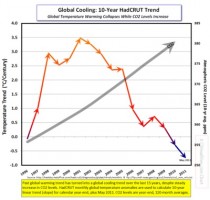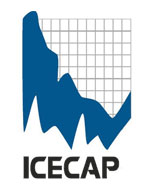By John McLean, Doomed Planet
What the Prime Minister should be telling us
Perhaps you have very publicly expressed your belief in dangerous man-made warming, just as many media organisations and politicians have done?
Who could blame you, for the United Nations, through its Intergovernmental Panel on Climate Change IPCC) is adamant that manmade emissions of CO2 are to blame for higher temperatures during the late 20th century. The media duly reports this to the world, assuming that surely the IPCC knows what it is talking about. On it goes, with a new prediction of disaster every week and hardly a word to be seen or heard from anyone who disagrees with the burgeoning environmental alarms.
Four successive IPCC assessment reports have ramped up the alarmism and claimed greater certainty that humans are to blame for global warming. In every report we learn of new predictions from climate models, those complex pieces of software that supposedly translate the climate system into mathematics. And we are told that unless emissions of man-made carbon dioxide are included, those models can’t match the historical temperature record.
If you were a politician, the pressure to believe is even greater. Not only do you have to agree with public opinion to maybe win an election, but the media are waiting to feast on your slightest hint of disbelief.
Now, however, it’s finally dawned on you. Temperatures haven’t risen for 12 years despite the rising carbon dioxide levels, and the predicted hotter, drier future has failed to materialise. Corals aren’t dying, and the islands that we’ve been told for over 15 years are going to disappear are still here.
News has slowly leaked out about the IPCC. It’s not concerned about climate at all, only the possibility that human greenhouse gases have a big influence on global temperature. The IPCC’s continued existence relies on it upping the ante in every report. After 4 reports over 17 years, the IPCC simply hasn’t the option of saying its conclusion is uncertain.
What are you to do now? You’ve painted yourself into a corner because your previous statements are on record and will be remembered. How can you back away from your earlier position and retain your dignity and credibility?
The solution might be easier than you think, and might even gain you a reputation for clear thinking. Just say that you want to “wait and see” for a few years.
Start by pointing out that despite the extra carbon dioxide in the atmosphere over the last 12 years, temperatures rose far less than in any previous 12 year period between 1977 and 1998. More carbon dioxide but less warming, can someone explain that to you? Surely, either carbon dioxide causes less warming than we’ve been told, or other climate forces must have much more influence - neither of which builds confidence in the climate models that predicted warming.
“Wait and see” makes perfect sense. See what happens in the real world rather than the fantasy world of flawed climate models.
Your second argument might be that temperatures have fallen sharply this year. Sure, a brief fall doesn’t mean a lot in climate terms, but why was there a drop in temperatures at all?
Most scientists will tell you that this cooling was due to a strong La Nina.
Two years ago a peer reviewed paper showed that the El Nino-Southern Oscillation (ENSO), which brings us La Nina at one extreme and El Nino at the other, has for 60 years been a good indicator of average global atmospheric temperatures about seven months ahead. The ENSO accounts for temperature so well that there’s little left to be explained by any other forces.
The paper also quoted the IPCC’s 2007 report as saying that the ENSO is poorly modelled, which, again, doesn’t say much for the models or the conclusions and predictions drawn from them.
Projecting the ENSO-temperature link forward seven months suggests that cooler conditions, not warming, will continue this year until about December. With this in mind and the observational data suggesting the IPCC’s claim is wrong, wouldn’t it be wise to “wait and see”?
Lately, solar scientists have told us that the sun is entering a quiet period with few sunspots. From 1645 to 1715, when this previously occurred, the world, and in particular Europe, suffered an extended cold spell. With this precedent in mind maybe it will happen again, so “wait and see” is the prudent action.
With no credible evidence for dangerous man-made warming, predictions failing to materialise, plausible alternative drivers of temperature identified, many scientific uncertainties and no credible reason for urgent action, surely any thinking person would opt to “wait and see”.
Who knows? Maybe in a few years the notion of significant man-made warming will be completely rejected and you’ll be praised for your foresight.
By Lawrence Solomon
A draft study produced by researchers at Yale University and four other research institutions has arrived at a surprising (to them) finding: The more that people are scientifically literate, and the more that they’re numerate, the likelier that they’ll be climate change skeptics.
Even more surprising (to them): socialistic types and free market types are poles apart in their thinking on climate change, with those most knowledgeable in each camp having the strongest views.
The researchers, most of whom hail from prestigious law schools, then wrestle with what to make of their results, which demonstrated (to them) that scientific knowledge and agility in math led to erroneous global warming beliefs.
“Our study results belie the conventional view that controversy over policy-relevant science is rooted in the public’s lack of scientific knowledge and its inability to engage in technical reasoning. As ordinary people learn more science and become more proficient in modes of reasoning characteristic of scientific inquiry, they do not reliably converge on assessments of climate change risks supported by scientific evidence,” they state.
Among the researchers’ conclusions: Teaching science in a neutral way, without understanding the students’ political orientation, can backfire, in that their knowledge may make them more skeptical. What is needed, the researchers say, is a means “to predict such controversies [as climate change] and to formulate strategies aimed at forestalling their occurrence or ameliorating their consequences should they occur.
“Development of these forecasting and management tools is the task of the science of science communication. Establishing the institutions and procedures necessary for promoting their reliable use in policymaking is a public good of singular importance to the wellbeing of modern, culturally pluralistic democracies.”
I don’t recommend that you tackle this study, which mostly reads like its title, The Tragedy of the Risk-Perception Commons: Culture Conflict, Rationality Conflict, and Climate Change. But the conclusions are penetrable for those who are determined, especially those who are scientifically literate and numerate climate change skeptics. The study can be found [external] here. Contact the lead author with your advice at dan.kahan@yale.edu.
----------
The Heartland talks are being posted here. Many talks - better education than a college degree these days.
Read about the debate between Raymond Pierrehmbert and Denis Rancourt about AGW and skeptics here. Hear the audio here.
C3 Headlines
Note: Just prior to this posting, it became public that a new Proceedings of the National Academy of Science (PNAS) study confirms that global warming has been missing since 1998. This new study refutes James Hansen, Al Gore and all the IPCC Climategate scientists claims of “unequivocal,” “unprecedented,” and “accelerating” global warming they have made over recent years. Global warming skeptics have proven to be correct, which the below material also supports.
In a previous post, we reviewed the last 15 years of HadCRUT temperature records, which show that global warming has become insignificant. In fact, one could accurately state that a global cooling trend is now replacing a global warming trend in an “unequivocal” and “accelerating” manner, using the greens’ own favored warming alarmist terms. (click to enlarge)

When examining the past 15 years of monthly global temperature anomalies, the per century change from a warming trend to a cooling trend becomes clear. Calculating 10-year linear trends from the monthly anomalies, the above chart plots end of year per century trends (plus the May 2011 10-year trend).
As can be seen, since 2001 the per century trends have conclusively switched from a global warming direction to a global cooling direction. In addition, the early 2011 temperature anomalies confirm what has actually been taking place since 2001. If the May 2011 10-year trend continues, the global temperature by 2100 will have decreased by -0.67C.
This warming to cooling reversal has happened in the face of “business as usual” increases in atmospheric CO2 levels. And this global temperature phenomenon reversal has occurred despite the “consensus” claims of IPCC “climate scientists” and predictions of the bureaucrats’ climate models. (The lower left chart clearly depicts how badly the climate models have failed.)
The lower right chart depicts a similar global cooling trend outcome over the last 15 years. Using the same monthly anomaly data, this chart’s per century trends are based on 5-year linear calculation.

Enlarged.
Regardless of how the temperature anomaly records are examined, the last 15-year span has seen the global warming trend fade as the world seemingly moves into a global cooling mode (the continental U.S. 15-year record of temperatures confirms this cooling trend). How long this will persist and how deep the cooling trend may become is pure speculation. And indeed, there is no concrete, emprically proven, scientific reason to assume the cooling will continue - the climate is complex and chaotic, which makes accurate predictions impossible.
These are the take home facts:
1. Global warming is neither unequivocal, accelerating, or even unprecedented.
2. Global cooling is becoming a trend but it’s not clear whether it’s accelerating and unequivocal.
3. Rapidly increasing atmospheric CO2 levels have not caused the requisite acceleration of global temperature increases.
4. CO2 levels appear to have little impact on global temperatures.
5. Global temperatures are in a deceleration mode, totally contrary to IPCC’s climate models.
6. Recent severe weather events (2010 and 2011) are not a result of increasing global temperatures; based on the actual temperature evidence since 2001, recent severe weather would more likely be a result of accelerating cooling.
7. Climate models have been stupendously wrong about global warming and climate change, time after time.
Additional modern temperature charts. Unequivocal fake warming, temperature fabrication charts.
Of couse, when your paradigm fails, they flail away and come up with some lame excuse as to why it failed. That came with a paper that claimed Chinese production of sulphate aerosols in their power plants was offsetting the warming ‘temporarily’. Of course, the ‘scientists’ used a computer model of the climate to show that natural fluctuations, such as variations in solar activity as measured by the record low in sunspots, cannot on their own explain the observation. See the nonsense here.
We knew this was coming. Predictably, Michael E Mann, at Pennsylvania State University, not part of the research team, said the study that warming was being masked by emissions from Chinese power plants was “a very solid, careful statistical analysis” which reinforces research showing “there is a clear impact of human activity on ongoing warming of our climate”. It demonstrated, Mann said, that “the claim that ‘global warming has stopped’ is simply false.” - The Guardian, 4 July 2011. Always an excuse for failure and Mann has a closet full.
“The political consequence of this article seems to be that the simplest solution to global warming is for the Chinese to burn more coal, which they intend to do anyway,” writes Judith Curry.
Curry from Georgia Institute of Technology, doesn’t find the economists’ statistical theatrics convincing. She wonders why the short-lived regional increases in particulates should have a global effect on temperatures. She also notes that there has been no increase in aerosols, either globally or over East Asia, from 2000 to 2006; Chinese emissions only rose in the period 2004 to 2007. Kaufmann et al do acknowledge that a La Nina weather pattern cooled the planet between 1998 and 2010. H/t Marc Morano.
The IPCC used the same aerosol excuse to explain the 1945 to 1977 cooling and support their greenhouse forcing argument.
Roger Pielke Sr. adds: One cannot use models to “show” anything. Real world observations must be paramount. Models are only hypotheses.
There is an informative article on this subject: Fildes, R. and N. Kourentzes, 2011: Validation and forecasting accuracy in models of climate change. International Journal of Forecasting. doi 10.1016/j.ijforecast.2011.03.008 which I posted here.
For example, they write
“...the structural weaknesses in the GCM identified here suggest that a reliance on the policy implications from the general circulation models, and in particular the primary emphasis on controlling global CO2 emissions, is misguided (a conclusion which others have reached by following a different line of argument, see Pielke Sr. et al., 2009).”



